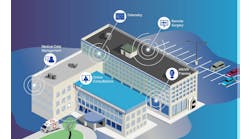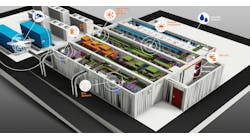The 5G Rollout: The Hype is Building Faster Than the Infrastructure
NEW YORK – You’ve seen the messaging: Super-fast 5G wireless is coming! And it will change EVERYTHING!
Data center and telecom professionals say that 5G will indeed be a huge deal, but that the hype and publicity around 5G is getting ahead of the infrastructure needed to deliver it. An example: Some AT&T phones are displaying “5GE” on some of its phones, short for 5G Evolution – which runs on its existing 4G LTE network.
“5G isn’t happening on the timetable that the cell companies would have you believe,” said Jeffrey Moerdler, who heads the Real Estate and Communications practice for the Mintz law firm. “5G cellular is in its infancy.”
“I think you’ll see 5G rolling out in pockets,” said Cliff Kane, CEO of Cleareon Fiber, a network service specialist. “It’s not going to be a profound impact this year or next year.”
The timetable of the 5G rollout was discussed by Moerdler, Kane and other panelists at recent CAPRE Greater New York Data Center Summit. 5G was in the news again last week when the FCC announced plans to auction off a key band of largely unused 2.5 GHz spectrum to advance the growth of 5G.
Verizon, AT&T and Sprint have each begun offering limited 5G service in several cities. Verizon has turned on 5G networks in Chicago and Minneapolis, while Sprint has pilot programs in nine cities this year. In addition to its 5GE for handsets, AT&T has offered 5G on mobile hotspots in a number of cities.
But analysts say these are limited deployments designed to prime the pump for a 5G future. The bottom line: 5G is indeed exciting, but 4G will be paying the bills for the next several years.
Early Days for 5G Infrastructure, Phones
If you’re new to the story, 5G wireless is the next-generation standard expected to bring widespread disruption of American business, as low-latency connections enable new services. 5G will require new transmission infrastructure, including thousands of cell towers and tens of thousands of antenna – known as small cells and DAS (distributed antenna systems) – that will be deployed on utility poles and other urban infrastructure.
“The infrastructure for 5G really isn’t in place,” said Moerdler. “While there’s lots of headlines about 5G testing by Verizon and AT&T, those are really small local tests. You won’t have large cities on 5G right away.
“The iPhone won’t be on 5G until the fourth quarter of 2020 or the first quarter of 2021,” Moerdler added. “It’s going to be phased up over the next year, but it will really be 2021 or 2022 before we see it on the chipset side.”
If the marketing is cresting ahead of the 5G wave, it’s not because it’s a false alarm. Telecom and data center experts agree that as 5G is deployed, it is likely to have a dramatic impact on data delivery to phones and devices, which currently rely on WiFi for about two-thirds of their data access.
“5G will be transformational in how it impacts culture and the economy,” said Kane. “There’s going to be a lot of money spent on it. It’s going to be gradual, and then it will ‘hockey stick.’ Incredible volumes of data will be created by 5G.”
“What’s coming is tremendous,” said Rob Nash-Boulden, Director of Data Centers at Black & Veatch, an engineering and construction firm, speaking at Data Center World in March. “The real traffic will come from devices and machines, not humans.”
Widespread use of 5G is “still about 24 to 36 months out,” said Lance Crosby, the CEO of StackPath, a security-focused content delivery network (CDN). “There’s only 12 cities we know of where 5G is up and running. This year it’s ‘commercial-only’ mode.”
The Economics of Creating the 5G Network
A key issue in the scale and timing of the 5G network is the cost of building out the infrastructure to support faster data, and the return on that huge investment. Large parts of existing telecom infrastructure must be upgraded and expanded.
“The biggest challenge is the economic model,” said Kane. “The CapEx-intensive model of 5G cannot be supported by the carriers alone.”
An overview of the different categories of 5G infrastructure investments, from analyst Sami Badri at Credit Suisse.
Sami Badri, a securities analyst at Credit Suisse, has been closely tracking the development of the infrastructure buildout for 5G adoption. Badri noted that 5G infrastructure spans several sectors of the communications world. Early phases include the deployment of more small cell antennas in dense metro cities, fiber backhaul to support the new antennas, and upgrades of dense network Radio Access Network (RAN) infrastructure, and equipment on macro cell towers.
“Telcos do not explicitly plan to monetize 5G,” said Badri, meaning that they may not have wide latitude to boost customer prices for faster service. “I think AT&T and Verizon have to spend. They will build out more robust businesses.”
A key transition for both the wireless operators and data centers is the re-architecting of telecom networks to become more cloud-like, shifting to a software paradigm that will make the networks easier to reconfigure and – in theory – make the telcos more nimble.
A key technology in the 5G transition is software defined networking (SDN), which separates the programming of routers and switches from the underlying hardware, simplifying the management of networks so administrators can automate many network functions, and dynamically manage their network operations. One tool that will play a leading role is network functions virtualization (NFV), which packages many network tasks in virtual machines.
“Network Function Virtualization (NFV) is becoming increasingly important in a 5G world,” said Badri, who said NFV is “a key strategic focus for all carriers in the 5G investment and network upgrade cycle through the next five years.”
Laying the Groundwork for New Applications
What will this 5G process look like? “Is it ‘if you build it, they will come?'” wondered Moerdler. “Today there isn’t a business use case. But to me, it seems inevitable that it will be built.”
Multiple industry observers predicted that 5G wireless will enable new applications and technologies that can take advantage of low-latency connectivity.
“The impact of 5G is that it facilitates other applications and companies that will require critical infrastructure,” said Phillip Koblence, Chief Operating Officer at NYI (New York Internet). “I think having the connectivity to enable the IoT and autonomous car to connect effectively is incredibly beneficial.”
“We can’t assume the enablement of the future will be the same, including the economics.”
Mark Thiele, Ericsson
Investment will likely track the markets where demand materializes first. “If you want to find out where the fast networks will be, follow the money,” said Nash-Boulden. “5G is not going to be a constitutional right for everyone, everywhere. If there isn’t a business case or use case, will consumers pay more for faster Internet?”
Some telecom analysts are closely watching the launch of 5G services in South Korea, which is the global pacesetter in the deployment of 5G networks. Initial plans for South Korean carriers don’t feature huge premiums, but also lack unlimited service tiers that are now commonplace in the U.S.
American wireless operators envision unlimited plans for 5G, but at modestly higher prices than current 4G offerings.
Jon Bonczek, the President of 1547 Datacenters, expects that users will love 5G once it becomes widely available.
“Give a consumer bandwidth, and they’re going to use it,” said Bonczek. “Today we’re using everything 4G has to give us. What we build will be consumed. More and more content is coming. We have to build for it, and build in the right markets.”
Risk vs. Reward in a 5G World
How do aspiring players in edge computing decide where and when to deploy capital to support 5G? That’s the tricky piece of the equation, according to Mark Thiele, an edge computing engineer at Ericsson who has been closely tracking trends.
“The risk in the market right now is determining the safety of the entry point,” said Thiele. “Realistically, now is an appropriate time to develop a strategy and partners to address the growth of this market when it happens. There is a lot of opportunity to overstep right now and get out over your skis. But I wouldn’t wait to see what models emerge.
“We can’t assume the enablement of the future will be the same, including the economics,” said Thiele.
StackPath CEO Lance Crosby said that 5G will loom large in new tech deployments in offices and homes.
“5G is important,” said Crosby. “But it’s one of those things that is so different that people will gravitate to it. I may have 1,100 IT devices in my new house. I think in five years, 1,100 will probably be normal for new tract housing. You can only do that with 5G.”






